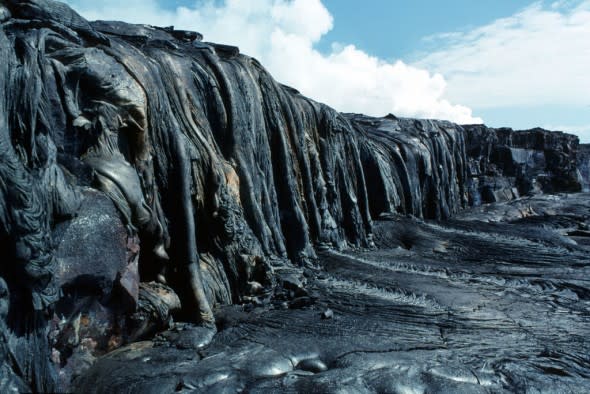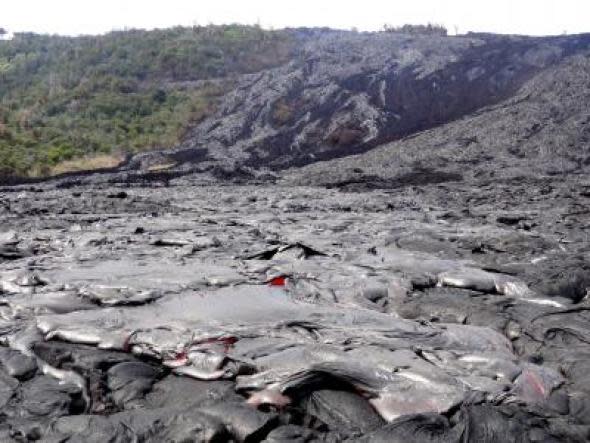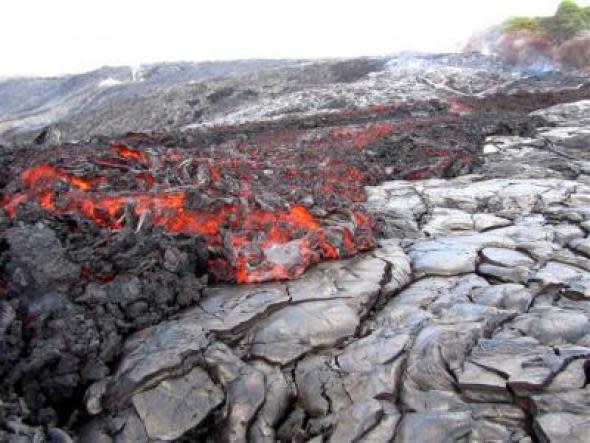A brief guide to different types of volcanic rock and lava flows
Far beneath the Earth's surface, a fiery world of viscous molten rock exists below the continental and oceanic plates, perpetually churning and shifting under the immense pressure and stress of a planet in constant motion.
Like in a lava lamp, molten rock, or magma, ascends to the surface over time. If the heat and gases of the magma buildup are intense enough, a volcanic eruption will occur, sending the magma out onto the surface.
When magma reaches the surface, it is referred to as lava if it maintains its characteristics as a fluid or viscous mass, according to the USGS. Lava can differ in its viscosity and composition.

Lava moves across the ground as a pahoehoe flow, Kīlauea Volcano, Hawaii. (Photo/Griggs J.D./USGS )
The Hawaiian island chain offers insight into the difference in lava flows and their compositions, featuring more fluid, basaltic lava. This contains less silicon dioxide, or silica, than other lava flows like andesites or dacites.
Shield volcanoes, like those found in Hawaii, are created by hot spots and are built up over time from low-silica lava pouring out onto the surface and cooling. Hawaii's shield volcanoes differ from the numerous stratovolcanoes that litter the Ring of Fire.
Stratovolcanoes are steep, conical volcanoes that were built by the eruption of viscous lava flows and pyroclastic flows.
Basaltic lava and the different types of lava flows
Basalt is one of the most common types of rock in the Earth's crust, according to USGS, and makes up most of the ocean floor. Basaltic magma is produced as the Earth's mantle, the region directly below the Earth's crust, melts.
The Hawaiian islands, and the shield volcanoes on them, are primarily comprised of basalt. Basalt is very dark in color - often black or gray.
There are three different types of basaltic lava flows that are common in Hawaii - pillow lava, pahoehoe and 'A'a.

The drapery was formed when lava flowed over a sea cliff onto the new land forming at its base. New land forms as lava deltas build seaward over steep submarine slopes of spatter, black sand, and pillow lava. (Photo/USGS)
Pillow lava, as the name suggests, are elongated flows of lava that form over repeated oozing and quenching of hot basalt, according to the USGS.
"First, a flexible glassy crust forms around the newly extruded lava, forming an expanded pillow," the USGS stated. "Next, pressure builds until the crust breaks and new basalt extrudes like toothpaste, forming another pillow."

Active pāhoehoe on the coastal plain of Kīlauea volcano, Hawaii. (Photo/USGS)
Pahoehoe lava flows, while still basaltic, differ from pillow lava in their characteristics, featuring a smooth, ropy surface that advances in a different pattern as it cools.
"A pahoehoe flow typically advances as a series of small lobes and toes that continually break out from a cooled crust," the USGS said.

View of the front of slowly advancing ‘a‘ā flow at the base of the pali, Kīlauea volcano Hawaii. (Photo/USGS)
'A'a lava differs from both pillow and pahoehoe lava, featuring a broken, blocked surface called clinkers. 'A'a (pronounced "ah-ah") is a Hawaiian term used to describe this unique lava flow.
"The incredibly spiny surface of a solidified ‘A‘a flow makes walking very difficult and slow," the USGS said. "The clinkery surface actually covers a massive dense core, which is the most active part of the flow."
As lava in the core travels, it carries the clinkers with it along the surface.
"At the leading edge of an ‘A‘a flow, however, these cooled fragments tumble down the steep front and are buried by the advancing flow," the USGS reported.
"This produces a layer of lava fragments both at the bottom and top of an 'A‘a flow."
